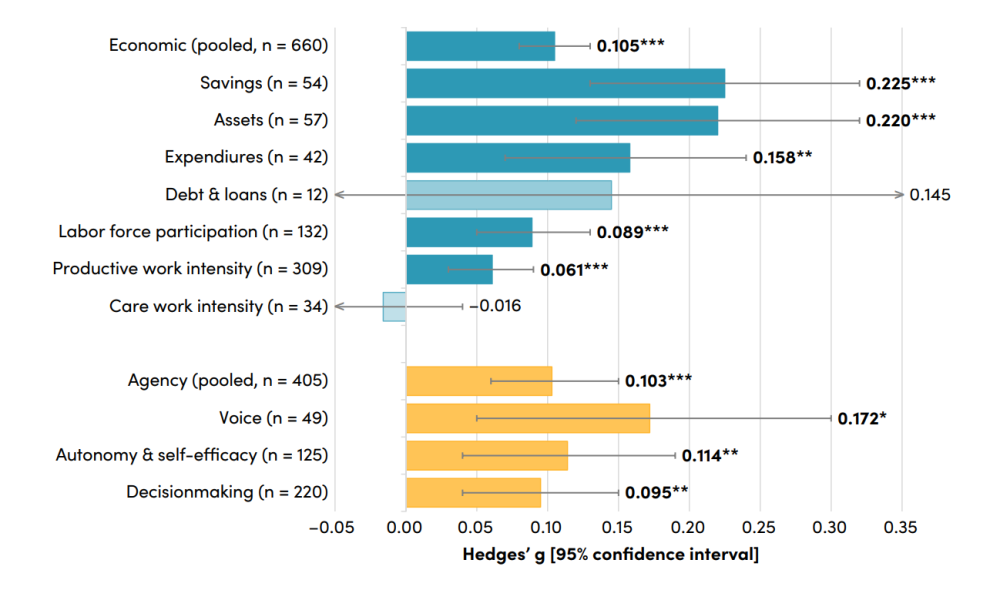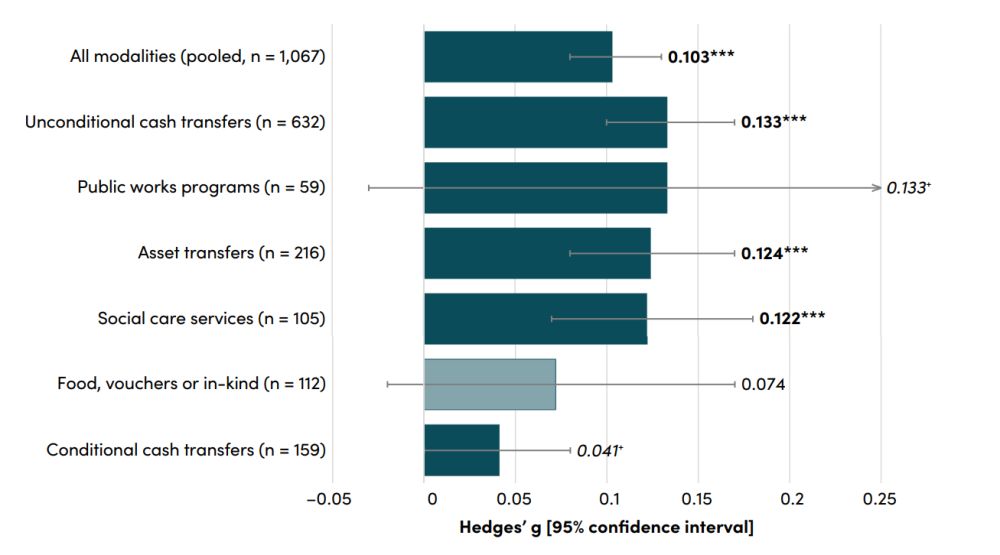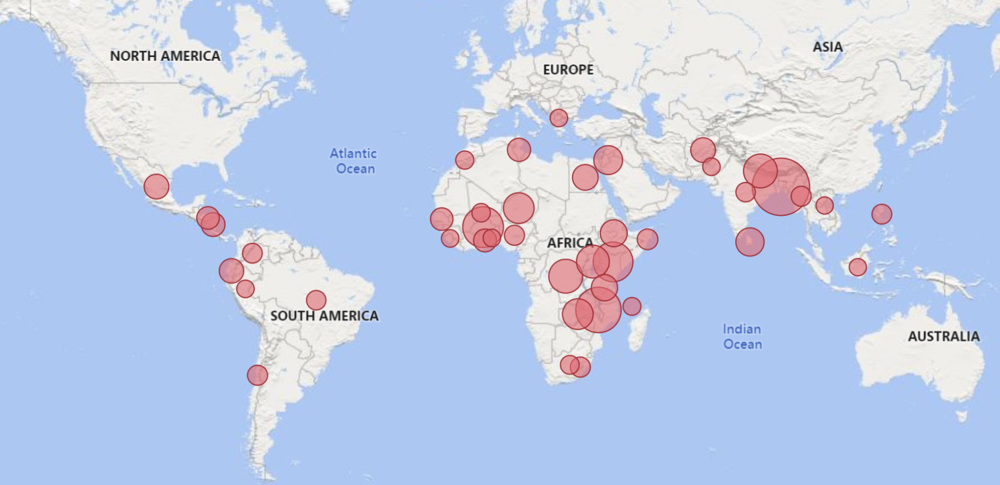Recommended
Social safety nets, including cash, in-kind, and asset transfers are at the forefront of government efforts to tackle poverty and inequalities—including in response to crises brought on by conflict, climate, and public health emergencies. There are acknowledged gender dimensions to the design and implementation of social safety nets, with rigorous evidence showing multi-faceted positive effects for women. This evidence has spurred calls to ensure systems, policies, and programs respond to and seek to close gender inequalities. Despite this promise, to date, there has been no comprehensive systematic review and meta-analysis of diverse social safety nets on women’s economic achievements and agency outcomes.
A new working paper closes this gap. We conducted a systematic review and meta-analysis aggregating evidence from 106 publications and 1,067 effect sizes from experimental evaluations of social safety nets across low- and middle-income countries. We include randomized evaluations of social safety net interventions, including unconditional and conditional cash transfers, food or in-kind transfers, public works programs, asset transfers (including graduation programs), fee waivers or subsides, and social scare services. We assess: 1) if social safety nets improve women’s economic achievements and agency outcomes, 2) which intervention modalities are most promising, 3) if effects vary by design and contextual factors, and 4) how interventions stack-up in terms of cost-benefit calculations. This blog summarizes four key takeaways from the review:
1. Social safety nets increase women’s economic and agency outcomes
An overarching conclusion of the review is that pooled effects from the meta-analysis show promising significant increases in women’s economic and agency outcomes (figure 1). Pooled effects on economic outcomes and agency outcomes are very similar (hedges g’s = 0.105 and 0.103), and comparable in magnitude to impacts of cash transfers on subjective wellbeing or impacts of economic empowerment interventions on intimate partner violence. These impacts are largest for economic outcomes including women’s savings, asset ownership, expenditure, labor force participation, and productive work intensity—while they are smaller or insignificant for debt and loans, as well as care work intensity. Impacts on agency are largest for women’s voice, followed by autonomy and self-efficacy, and finally decision-making. These results demonstrate that social safety nets have widespread positive impacts on women’s outcomes across many different indicator domains, increasing among others, engagement in productive activities, wealth stores, and agency to take life decisions.
Figure 1. Pooled effects on economic (top) and agency (bottom) outcomes
Note: Pooled effect sizes are calculated across outcomes using standardized impacts; +p<0.10, *p<0.05, **p<0.01, ***p<0.001
2. Effects vary across social safety net modalities
A second key finding is that pooled effects vary across social safety net modality (figure 2). For example, there are larger effects for unconditional cash transfers (hedges g = 0.133), asset transfers (hedges g = 0.124) and social care services (hedges g = 0.122) as compared to food, vouchers or in-kind transfers, and conditional cash transfers, which have smaller insignificant or marginally significant effects. Meanwhile, public works programs have similar impacts in magnitude to unconditional cash transfers, however, they are only marginally significant—likely in part due to the smaller number of effects included and reduced statistical power. Significantly smaller effects of conditional cash transfers also carry over to the meta-regression analysis, showing that these types of programs have smaller overall impacts as compared to unconditional programs. While we are not able to definitively unpack why this is the case, one hypothesis is that conditional and in-kind transfers are less likely to give women autonomy over spending—and more likely to (potentially) increase burdens on women’s time due to the necessity to adhere to conditionalities.
Figure 2. Pooled effects by social safety net modality
Note: Pooled effect sizes are calculated across intervention types using standardized impacts; +p<0.10, *p<0.05, **p<0.01, ***p<0.001
3. Few design and contextual factors explain variation in effects
We tested a large number of design and contextual factors in a meta-regression framework to understand what factors might correlate with larger impacts across studies. These included factors like where the study took place (region, fragility and urbanicity), who was targeted for and who implemented interventions, if interventions included additional complementary programming, as well as the value, duration, and follow-up period for measuring impacts. Unfortunately, we find few consistent associations. However, there is some evidence that interventions with multiple economic components and which are measured within the first year after an intervention stopped are more likely to have larger effects. Nonetheless, the geographic spread of included effects gives some indication of poverty and gender norms underlying results (figure 3). Over half (52 percent) of effects come from sub-Saharan Africa, while South Asia and Latin America have (18-19 percent) of effects and a limited number of effects come from Middle East and North Africa (6 percent), East Asia and Pacific (5 percent), and Europe and Central Asia (1 percent). The majority of studies come from 2015 and later (87 percent), thus signaling a quickly expanding evidence base, particularly on the African continent.
Figure 3. Geographical distribution of overall effect sizes (n = 1,067)
4. Cost-benefit calculations point to promising investments—however few undertake gender analysis
In total, we find 24 studies (or 23 percent) which report on some measure of cost-benefit analysis—either benefit-cost ratios (18 studies), internal rate of return (12 studies), cost-effectiveness (5 studies), net present value (4 studies), or economic multipliers (2 studies). The overwhelming majority of studies show that social safety nets are ‘good investments’, however only five studies included at least one benefit that was woman-specific—with the remaining studies reporting only on household-level measures. This result indicates that we have very little understanding of how benefits to women specifically factor into cost-benefit calculations. Thus, holding other assumptions constant, studies are largely undercounting overall and undercounting the gender-related benefits of social safety nets.
What does this mean and where should the research go next?
These findings are a promising confirmation that social safety nets can have multiple beneficial effects for women—however underscore that modality and intervention design may matter. Findings also indicate the importance of further rigorous research to close evidence gaps—particularly for studies which can unpack key gender-informed intervention design components related to complementary programming, targeting, value of benefits and how these might play out in less researched settings. In addition, we need more information on outcomes like care work participation and intensity, leadership and aspirations and for certain social safety net types with fewer estimates—including social care services and fee waivers. Finally, despite robust evidence, policy makers and implementers struggle to implement and finance gender-responsive social safety nets—thus, more work is needed to advocate for and reduce political barriers to adopt and scale-up systems, policies and programs that work for women.
We thank members of the CGD ‘cash, care & data’ workstream for discussions and input that shaped the review at various stages, including comments on draft versions of the review.
Disclaimer
CGD blog posts reflect the views of the authors, drawing on prior research and experience in their areas of expertise. CGD is a nonpartisan, independent organization and does not take institutional positions.
Image credit for social media/web: gustavofrazao / adobe stock











